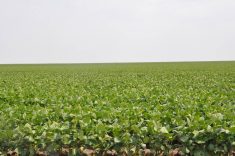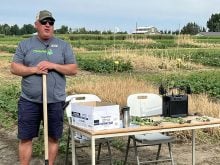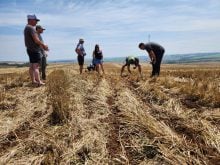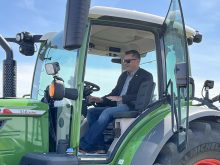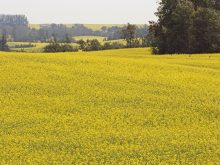Feeding the planet is a global responsibility, and more than 20 Alberta producers travelled to the southern hemisphere last fall to see how agriculture is done in that part of the world.
Farming Smarter organized the tour to Brazil in October to show producers from southern Alberta about ag production practices in that country.
Brazil is a top-five nation when it comes to arable land, although growth in cultivated land has stabilized in the last few decades.
Read Also

Fertilizer method’s link to emissions studied
A researcher says others studying greenhouse gas emissions aren’t considering how the loss of nitrogen into the atmosphere correlates with fertilizer application or if there is an impact to yield.
“There’s been a lot of work to preserve the rain forests and those natural ecosystems,” said Lewis Baarda, a certified crop adviser/field manager who was part of the tour.
”There are 2.5 million sq. kilometres, and that’s about four times as much arable land as Canada, so they are a big player and there’s a lot going on there.”
Brazil was traditionally known for citrus, cotton, coffee and sugar cane production but has expanded into soybean and corn over the last couple of decades.
In his slide show at the Farming Smarter Conference and Trade Show in Lethbridge in mid-February, Baarda compared Canada to Brazil in crop production. As of 2024, the country is the second biggest grain exporter in the world and the fourth overall grain producer. It is also the world’s largest exporter of coffee, cotton, organic honey, beef, poultry, cane sugar, orange juice and tobacco.
The country produces 169 million tonnes of soybeans, accounting for 40 per cent of global production.
“Quite frankly, it’s absurd how much soybeans they are producing. Every region, there’s lots of heat and double cropping. They are big producers of soybeans, and corn, but once you get through those two major crops, the diversity drops big time. There are not a lot of acres of anything else there. There’s a lot of speciality things,” said Baarda.
“Compare it to Canada — lots of wheat, canola, corn, barley, some soybeans as well. Looking at that with economic concentration, your index would be a lot more diverse for Canada than it would be for Brazil.”
The Farming Smarter group visited the states of Barauna in the south and Mato Grosso further north and west. Farming Smarter was able to meet many people that were directly connected to the industry, including farmers and researchers.
“There were different ways of European immigration coming into the country throughout the 20th century,” Baarda said of the big pushes of immigration to the nation in the 1930s, 1950s and 1970s.
“They struggled at first. The Dutch government sent experts over to Brazil to help Dutch farmers out and get things rolling.”
Brazil features light, highly-oxidized, red-looking soil that benefits from conservation farming methods.
“I looked at a chart of adoption of conservation tillage and it has gone up and up and up and has been a big part of Brazil being able to increase production, even though the land base has stabilized,” said Baarda.
All the farmers who Farming Smarter visited were quick to mention the legislation and regulations Brazil has put on farmland. A certain percentage, depending on the area, must be preserved for forests.
“In the Barauna state southern area, depending on the region, it can be 10, 20, up to 40 per cent of their land has to stay forest. In Mato Grosso, closer to the Amazon, 80 per cent of their land has to stay in forested acres,” said Baarda.
“It’s highly punitive and very regulated. They are worried about the perception of people like us.”
The political climate in Brazil has been a bit of a flip-flop, switching from liberal to conservative governments. The current climate has left farmers nervous to express their thoughts to Farming Smarter on the current administration.
Labour is a concern for the sector, with the more fortunate living near urban centres from where they can access workers.
“When they lived further away, often these farms would have little communities set up with schools and churches — a place where you could work on the farm, make a career and make a living without spending hours and hours on the road every day,” said Baarda.
Southern Brazil has big agricultural co-operatives that are set up to provide a variety of services for farmers — source their seed and fertilizer, apply seed treatments, conduct agronomic research and market their product.
“You pay a fee to be part of the co-operative and in some cases, if you are a founding member, you pay a lower fee and you’re allowed to be on the board. You are highly incentivized to be part of a co-operative. Some of these are so big, they’ve got $7 to $8 billion net revenues at the end of the year. It’s big, big business.”
Much of the research and equipment is similar to Canada, such as rotations, ways to till, disease control and crop breeding. Nematodes are big soil pests in Brazil, given their high production of soybeans.
“They are baking the sand and soil samples to do pot tests so they have an uncontaminated base line,” said Baarda.
“Bio-stimulants is a huge thing. Everywhere we went, everybody was talking about bio-stimulants. They are using them to have their crops grow better and manage pests and everything. They do a lot of these things in-house. I don’t think there’s a lot of government support for the research type of thing. It’s the companies and the co-ops that have the buy-in from the farmers, which supports the research.”
Proving the point was a farm show Farming Smarter attended. It began in 1989 with about 15 exhibits and last year saw 400,000 people go through with 600 exhibits.
Co-operatives are also looking at value-added industries. Farming Smarter visited Agraria, the largest malt house in Latin America.
“They have doubled down on barley, in particular malt barley. They have a brewery within their facility. It’s not a commercial brewery but is set up where they are brewing their malts and they are bringing in their clients from all over the world, showing them this is the high-value beer we can brew with your malt,” said Baarda.
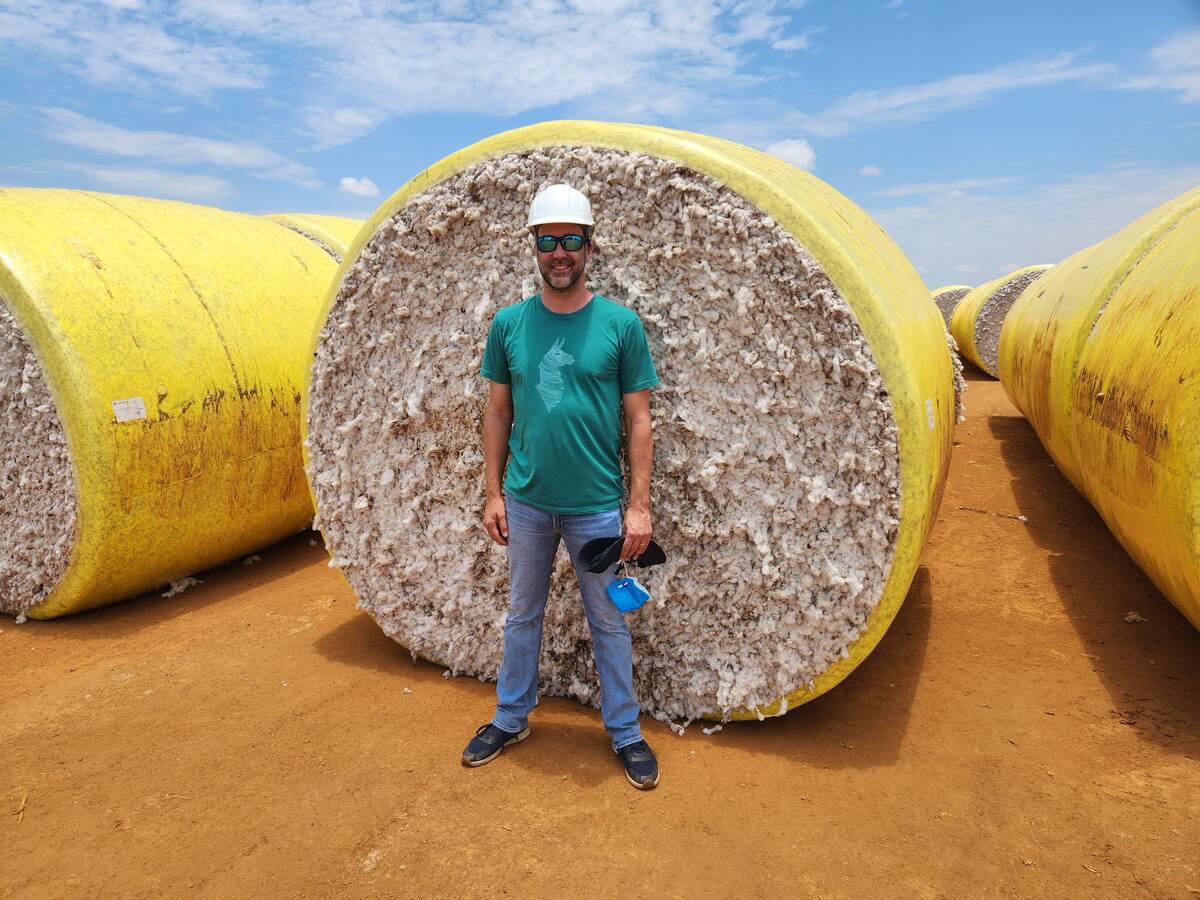
“They have a school in the facility as well, where they are training people how to brew these malts so they can take these people to these companies to show how to brew their malt properly. They have creative ways to add value to their products and get the best market they can for it.”
The tour participants also they saw their share of challenges. Transportation is still primitive overall,with almost everything shipped by truck. There is no rail system to speak of.
In Mato Grosso, Farming Smarter entered a warmer area of the country, which features more distinct separations of summer and winter seasons near the rain forest.
With corn and soybeans, trip members were also exposed to the cotton market. Farming Smarter’s stops included one of the largest cotton farms in the world, spanning 1.5 million acres, with 5,000 engines powering the farm.
The massive farm handles all aspects of the crop, from raw cotton, different grades of cotton, cotton seed, some meal and oil, and husks compressed into briquettes. Because Brazil does not have access to natural gas as is the case in Canada, Brazilians burn a lot of eucalyptus wood for their energy needs.
“It’s essentially like a little tree. You think it’s a plant, but with the amount of work you need to put in for cotton to grow is wild. Every third or fourth day they are putting something in to keep it going,” said Baarda,.
The value of genetic advancements becomes clear when looking at their crop rotations, he added.
“If you have a short enough season for a soybean, you can fit in your cotton or corn in the same calendar year. When we were there, we drove for miles and miles and all we saw was cotton stubble and soybean either growing or being planted, so again, not a lot of diversity.”
In all, Baarda was surprised by how big of a powerhouse Brazil is in the world agriculture market — the scale and scope of the industry with the multiple crops and the science and innovation driven by the marketplace and specialists in co-operatives vertically integrated to make things happen quickly.
“I think 60 per cent of what they produce goes to China, but they are also developing these specialty markets with cotton and malt barely. We may run into things with the U.S. and they may run into things with China, but they are trying really hard to diversify,” said Baarda.





